We have said it a hundred times (and probably more) so we already know that relationships are at the heart of community building, and we wanted to use April to explore more around how we identify who to build relationships with and how to build them so that they are valuable for everyone involved.
These relationships involve members of course, but they also involve stakeholders, leaders, colleagues, and peers. So, how do we get started and even identify who we should be meeting and connecting with?
Here's what we found...
April in TheCR Network: Roundtable Calls
Our first call of April focused on internal relationships, or how we can reach across all of the aisles to connect with our colleagues in different departments within our organizations.
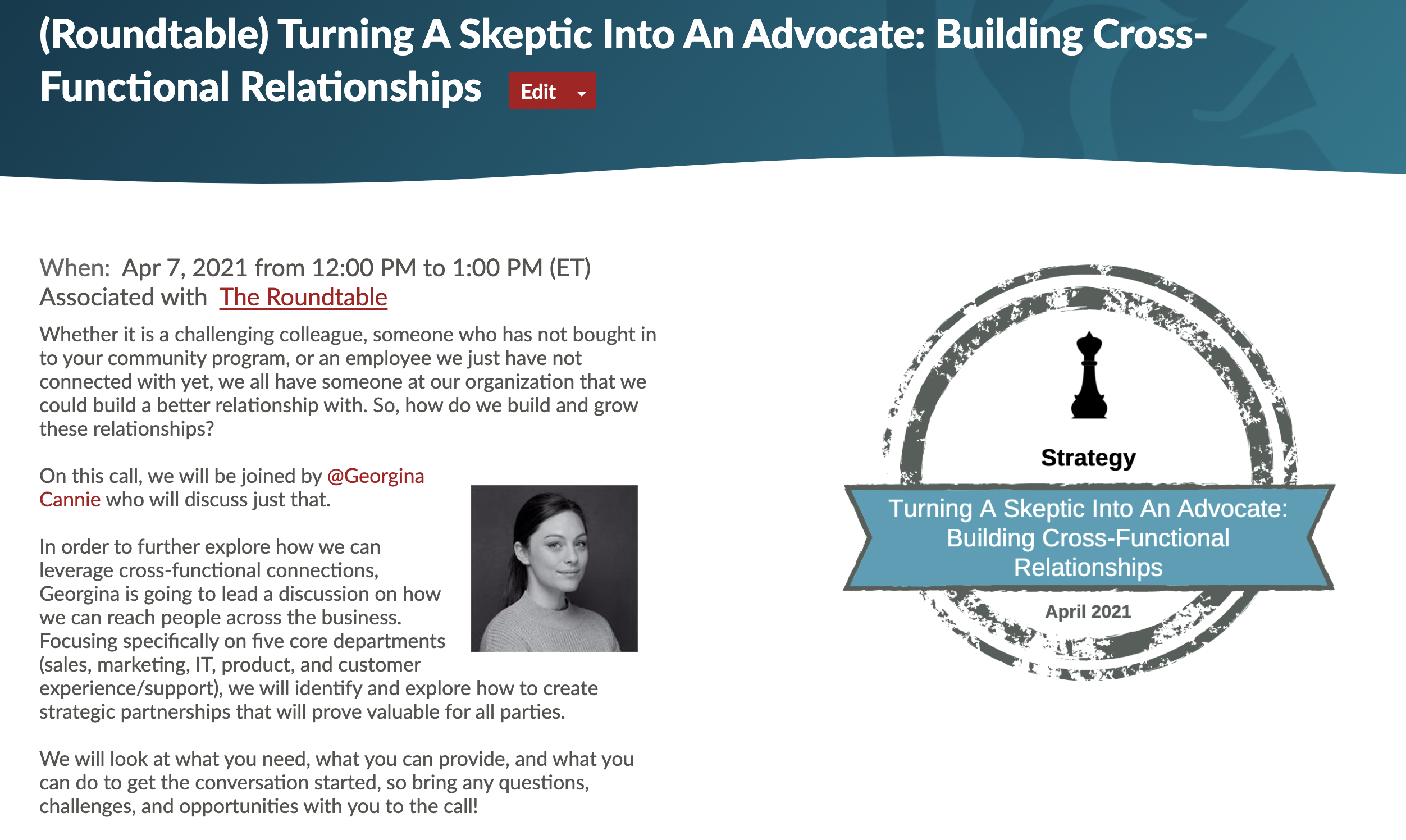
On "Turning A Skeptic Into An Advocate: Building Cross-Functional Relationships", we were joined by @Georgina Cannie who talked us how she thinks about identifying, building, and growing relationships with colleagues and leaders across our organizations.
Georgina walked through both the offers and benefits gained from connecting with five core departments: sales, marketing, IT, product, and customer experience/support. We also explored how we can create strategic partnerships that will prove valuable for all parties involved.
While each organization may be different (with different contexts and people involved), building these relationships always goes back to understanding the value and what others are looking for as well as understanding the importance in the little things. You cannot always show up at someone's proverbial door when you need something, you need to put in work and give something in return. Building cross-functional relationships should not just be transactional, but should be a nurtured relationship where you get to know the person, their priorities, and their needs in order to truly collaborate and create value for both of you.
So my big takeaway is to not treat cross-functional relationships like a box you need to check off on a to do list, but an opportunity to connect with another human being who you may create a wonderful working relationship with down the line.
If you want to catch up on this call, you can find the Roundtable Recording here.
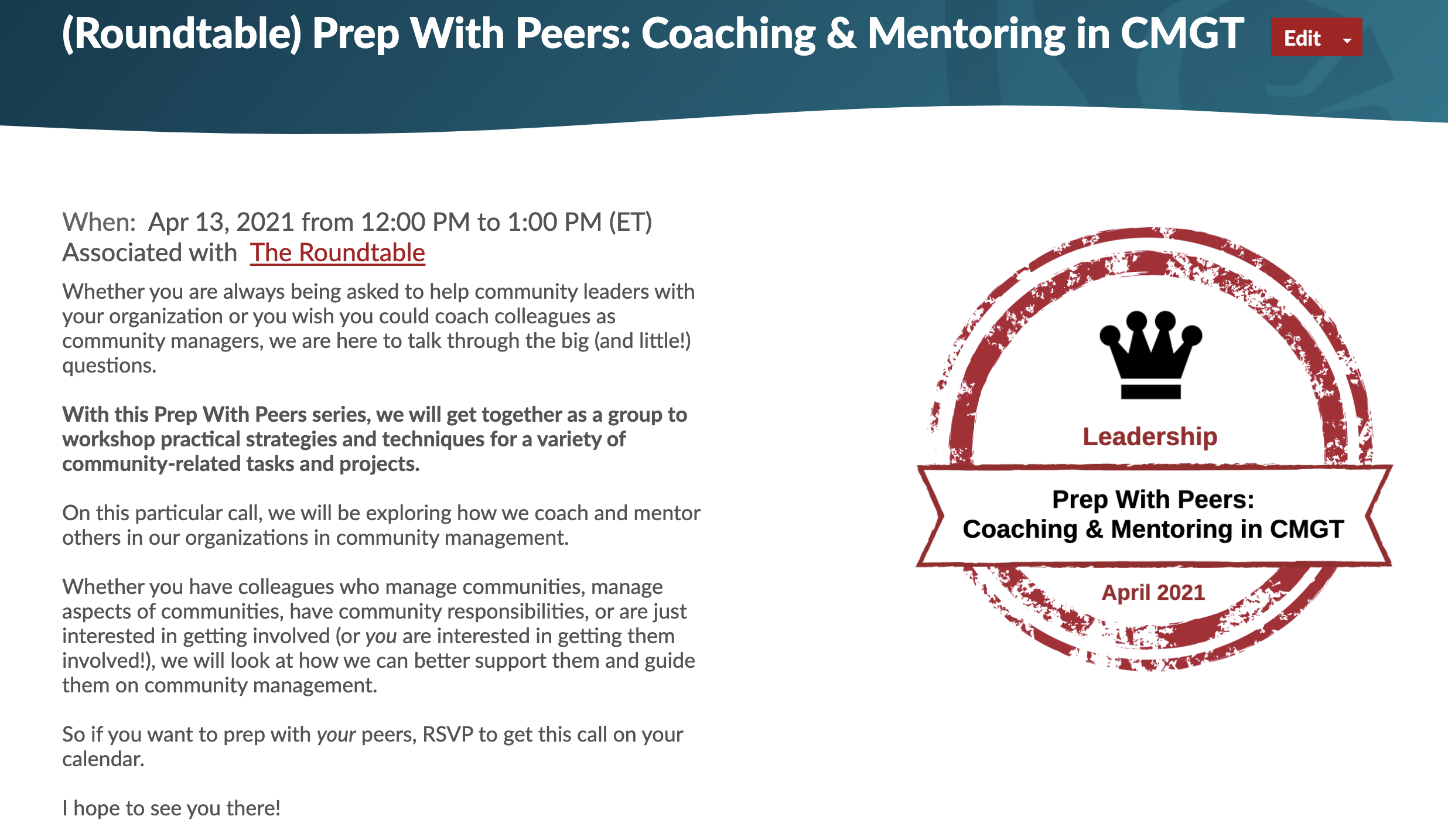
Our next Roundtable Call of April -- another instance of our Prep With Peers series -- "Prep With Peers: Coaching & Mentoring in CMGT", acted a bit differently than a "traditional" Roundtable Call in that it functioned more as a peer workshop: bringing members together to explore and practice how we can coach and mentor others in community management. On the call, we looked at a variety of contexts and worked on exploring how we can reach our colleagues, leaders, and members who are or want to be involved in community in order to set them up for success.
We used the group space to talk through our use cases and then broke up into groups to workshop the "who" (who is the person who want to coach and what are their motivations) and the "how" (how can we reach them, how will they be using the community) to look at how we could better support these folks and guide them in community management.
While this call functioned more as a working session and was more about us exploring how we can navigate relationships already built, understanding more about these people and their goals/priorities is a key part of understanding how we can support and leverage these relationships in a practical application. Because, once you have identified those colleagues who would be great community leaders, what do you do?
You practice mentoring and coaching, of course!
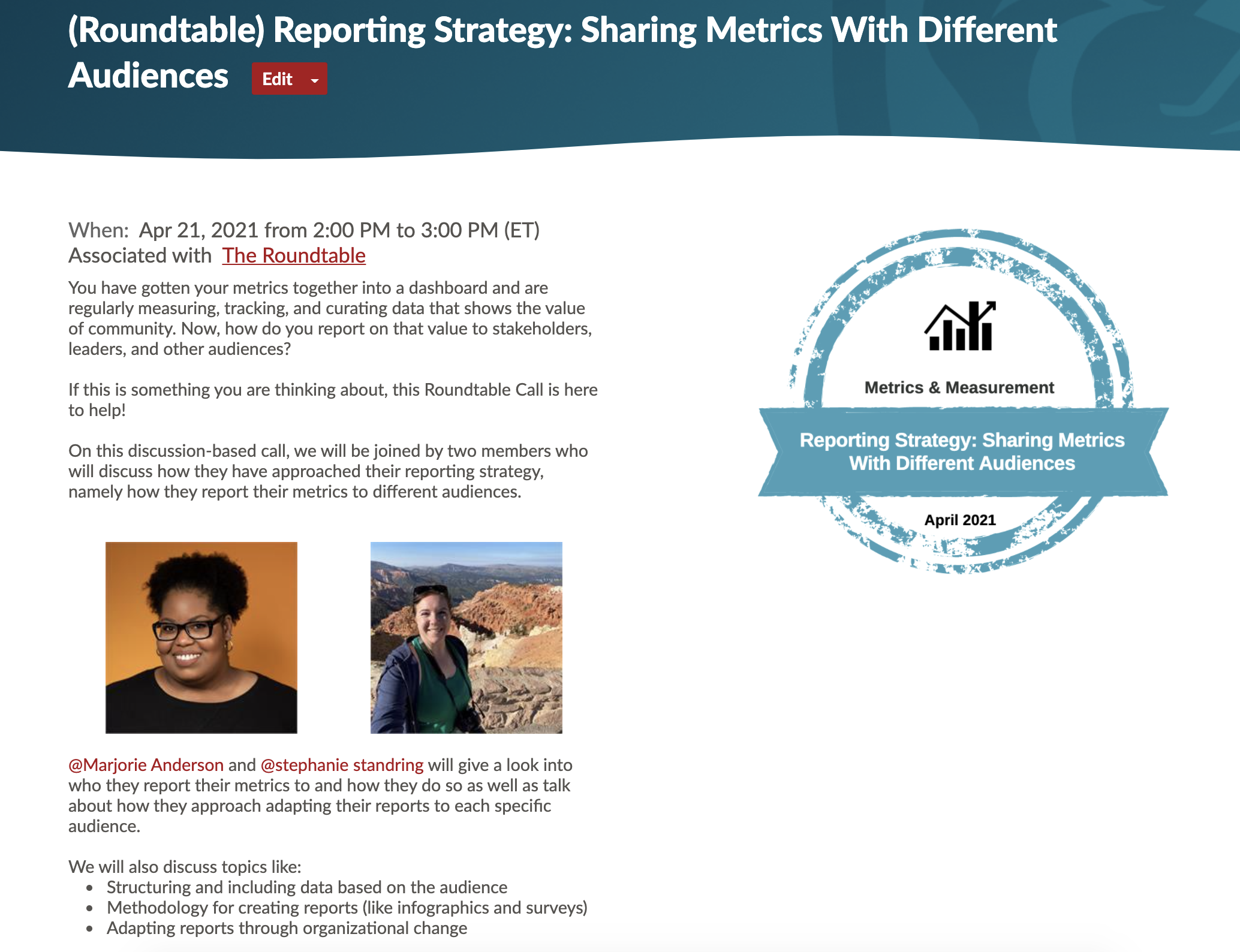
The next call we held in April, "Reporting Strategy: Sharing Metrics With Different Audiences", focused on an interactive discussion with two members -- @Marjorie Anderson and @stephanie standring -- and their experiences with building out a reporting strategy, or, how they report metrics to and for their organization.
We heard about who they report their metrics to, how they do so, and talked about how they approach adapting their reports to each specific audience. To get specific, Marjorie and Stephanie discussed topics like structuring and including data based on the audience, methodology for creating reports (like infographics and surveys), and adapting reports through organizational change.
We did not focus on the exact metrics on this call, but the people that are being presented them. In order to communicate and prove value, we need to know who we are talking to and how to talk to them, so identifying these key relationships is a huge part of that success.
One key takeaway I had from this call is that this all takes time. We cannot rush relationships and we may have to recreate reports, represent metrics, and try, try again multiple times. That is okay! That practice and that work will pay off in the end when we have shared our successes with the right people who can invest more into our communities.
But, first things first, we need to find out who that who is!
If you are interested in listening in to this call, you can find the edited Roundtable Recording here.
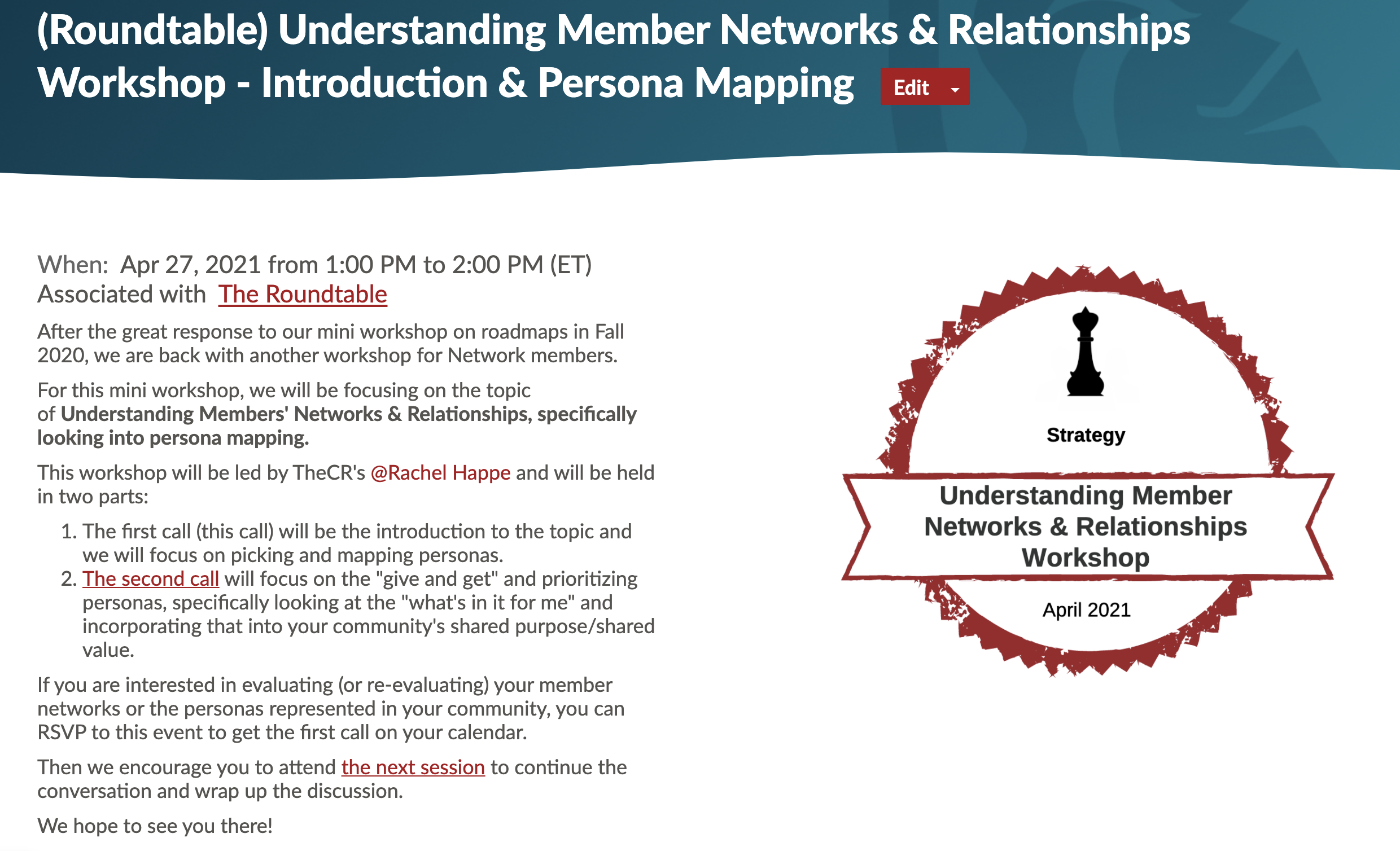
Our last calls of the month compromised a mini workshop for TheCR Network members on "Understanding Member Networks & Relationships". Our first call focused on Introductions & Persona Mapping and gave us a great understanding of how persona mapping, member segmenting, or whatever you may identify it as plays a large role in our overall community strategy and is worth the effort it takes to work through the exercise. TheCR's @Rachel Happe led us in thinking about how we can pick personas that we need to, should be, or even can reach for our community and how we can use influencers and motivations to understand what may drive a potential member segment to engage.
Our second call looked at Prioritization & WIIFM and used the work we did in between the two calls (mapping out some member segments and influencers) to then take that a step further and incorporate this work in our community's shared purpose and shared value. Through specifically focusing on the "give and get" and the "what's in it for me" (or WIIFM), we were able to prioritize who we should be bringing into our community's and working to engage through our strategy.
A big piece of this work is learning that there is no "right" or "wrong" answer to these segmenting/motivations questions as everyone's use case and each person is different. We all will not have the same responses, the same "give and get", or the same segments, and the value is in working through the exercise to unearth knowledge you did not know beforehand. You do not know what you do not know, right?
While these calls did not give us a true "answer" or leave this topic wrapped up in a bow, it gave us some great directions to go in to continue identifying, building, and exploring these key relationships, especially the ones we might have been missing.
If you want to listen in on the first part of this mini workshop, you can find the Roundtable Recording here.
We heard some great examples and had some great discussions this month, so why not round it out with what we learned about members of TheCR Network overall...
What Did You Think?
For the month of April, we opened up a poll to take a look at who we may not currently be working with, but would like to be. Under the theme of "identifying key relationships", we wanted to identify the key relationships that we all could be building across our organizations.
So, in order to do that, we asked TheCR Network members: What department in your organization would you most like to partner or collaborate with?
What did members think? Let's find out...
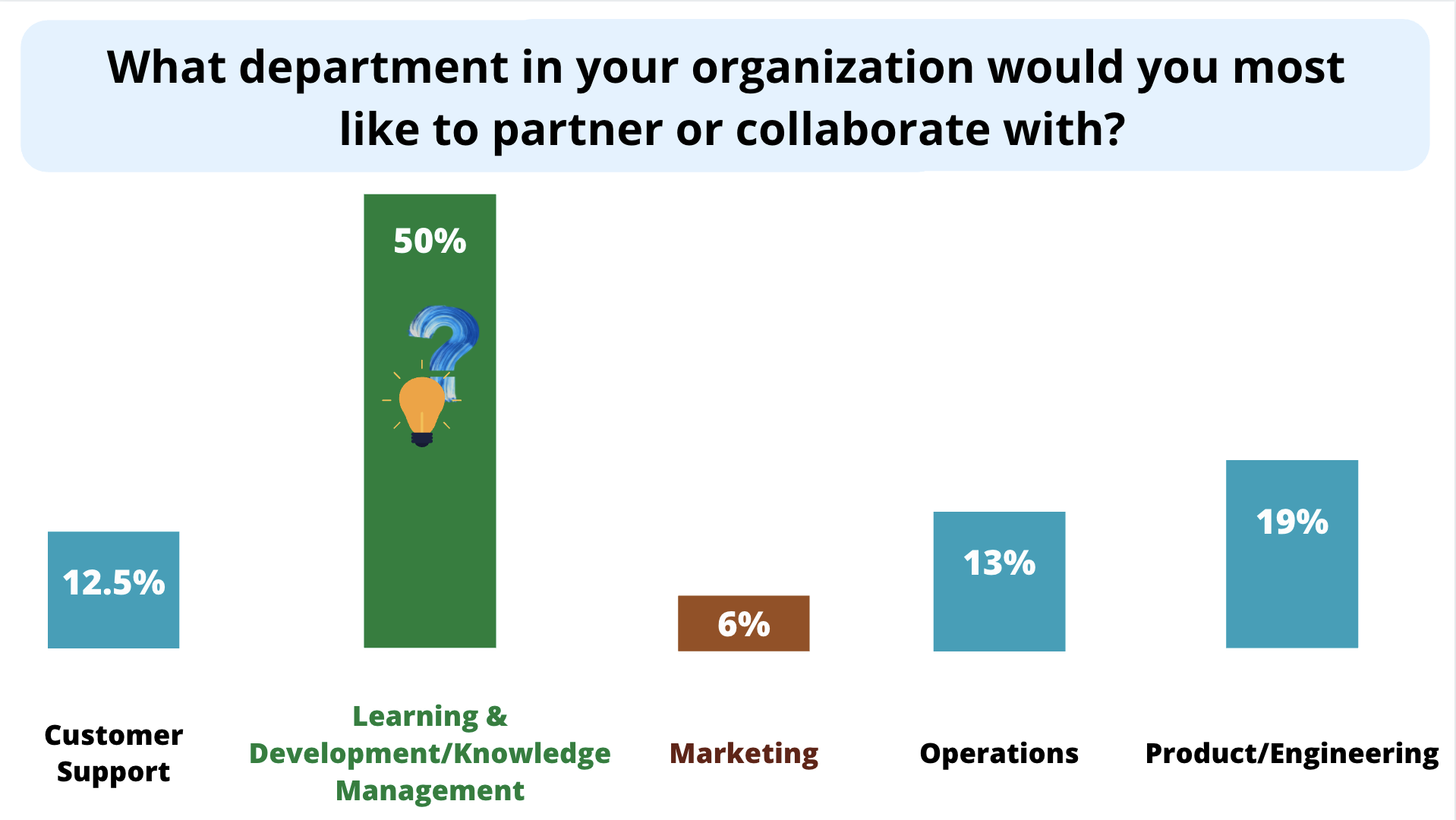
The poll results come from a sample size of 16 respondents and show that members feel pretty strongly that they would like to collaborate more with their L&D/KM or Learning & Development/Knowledge Management department in the organization. With 50% of respondents citing L&D/KM as their primary choice, Product & Engineering came up second at 19% and Operations and Customer Support were effectively tied for third with 13% and 12.5% of respondents saying they would most like to collaborate with them respectively.
We know that communities propel engagement and transform organizations through impacting complex business objectives and enabling business functions, and, according to the State of Community Management 2019 (chart on pg. 23) 68% of internal respondents and 43% of external respondents saw learning & development functions being supported by community (along with 66% of internal and 45% of external for knowledge management).
All of this data shows the immense opportunities we have by collaborating with these functional areas. And they are not the only ones involved in valuable relationships. Growing cross-functional relationships plays an important role in meeting business goals and seeing impact on these complex business objectives like getting faster answers for members and seeing organizational culture change internally. But, before we can get to that place, we need to identify the places where we can reach out, connect, and grow. And during April, we focused on just that.
So, if you followed along with the process in April, we can now think about how we can generate and sustain this value we are creating...
So, Where Do We Go From Here?
In following our journey of building on foundations and putting the pieces in place to create value, we are looking forward to what we can and will be doing in the future. We know communities have potential, so let's explore that.
For the month of May in TheCR Network, we are looking forward to exploring how communities Create and Accelerate Impact. This will include looks at the strategic, operational, and tactical work that goes into this impact as well as a broader look at what that impact could entail through the release of our annual State of Community Management report findings.
So, if any of these conversations or concepts have sparked an idea or recommendation from you, let us know! While we plan our programming calendar, we also leave space for reactive programming, spur-of-the-moment topics, and member involvement, so leave us a note or send us a message and we'll get something together to address your topics of interest.
And if you're not a member of TheCR Network, or if you know someone who isn't a member of TheCR Network, but would love to participate in these conversations, please reach out! We're happy to talk about how you or they can get involved.
If you'd rather do that yourself, you can find out more about how to join TheCR Network here.